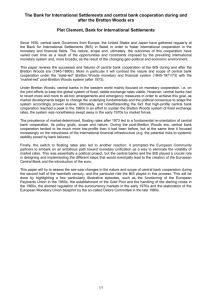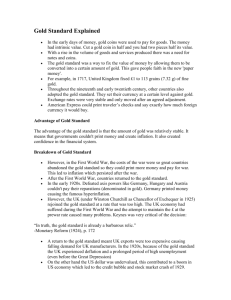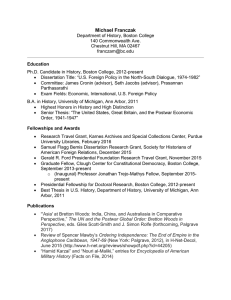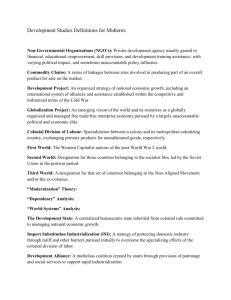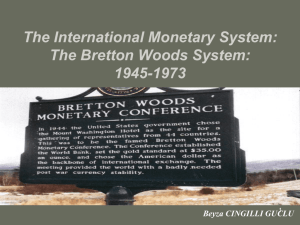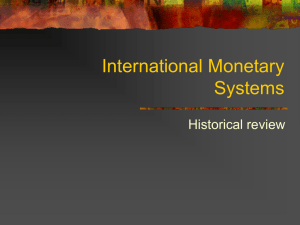Embedded Liberalism & Bretton Woods International Monetary Order
advertisement
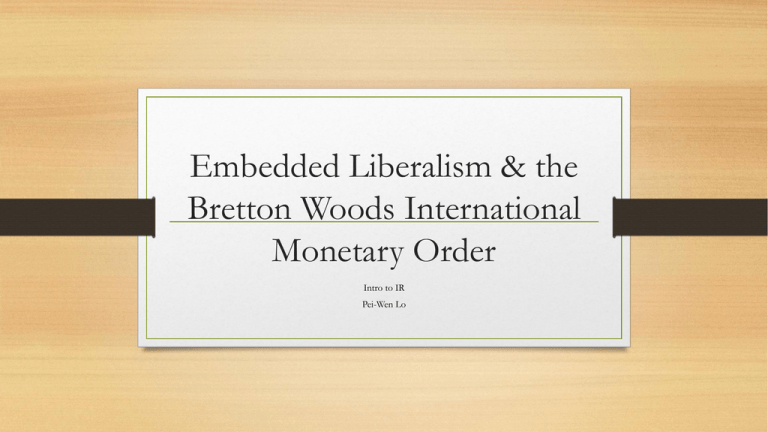
Embedded Liberalism & the Bretton Woods International Monetary Order Intro to IR Pei-Wen Lo Define Embedded Realism • First introduced by American International Relation Scholar, John Ruggie (1982) • The term described the policy orientation of the international economic order that existed from post-World War II until the 1970s, and to explain the social conditions upon which it rested Historical Background • The consensus was to restore free trade before World War II while enabling states the freedom to provide welfares • Embedded liberalism came into existence as a reflection of the international consensus The Formation of Bretton Woods System • The Bretton Woods System was an actualization of embedded liberalism • 44 allied nations attended the Bretton Woods Conference held in Bretton Woods, New Hampshire in 1944. • Negotiations were led by the Treasuries of the UK and of the U.S. • The compromise made at the conference reflected more of the American influence, reflecting the hegemonic position of United States after war Objectives of the System • The goal of the Bretton Woods System was to restructure the postwar economic order with a combinations of two objectives • First, to revive free trade damaged by war and Great Depression of the 1930s • Second, to provide states the freedom to intervene in their economies to ensure full employment and welfare programs Agreements • The agreements made at the conference state that, “The nations should consult and agree on international monetary changes which affect each other. They should outlaw practices which are agreed to be harmful to worldwide prosperity, and they should assist countries to overcome short-term exchange difficulties” (Ruggie 1982). Three Key Features of the Bretton Woods System • The Bretton Woods System was a monetary regime joining an essentially unchanged gold exchange standard, supplemented only by a centralized pool of gold and national currencies, with an entirely new exchange rate system of adjustable pegs. Three Key Features of the Bretton Woods System • First, a compromise was sought between the two extreme alternatives of either freely floating or permanently fixed rates. • The floating rates were considered as having discouraging effects on trade and investment. • In practice, the 'pegged rate' or 'adjustable peg' currency regime, also known as the par value system was established. Members were obligated to declare a par value (a 'peg') for their national money and to intervene in currency markets to limit exchange rate fluctuations within maximum margins (a 'band') one per cent above or below parity. • However, they also retained the right, whenever necessary to alter their par value to correct a 'fundamental disequilibrium' in their balance of payments. Three Key Features of the Bretton Woods System • Second, all governments agreed that if exchange rates were not to float freely, states should also have an adequate supply of monetary reserves. • In the end, a system that reflected U.S. preferences was created. • It was a fixed pool of national currencies and gold subscribed by each country. The subscription was to be paid 25 per cent in gold or currency convertible into gold (the dollar) and 75 per cent in the member's own money. When short of reserves, each member country was entitled to borrow needed foreign currency in amounts determined by the size of its quota. Three Key Features of the Bretton Woods System • The third feature was to avoid recurrence of the type of economic warfare in the 1930s by imposing certain restrictions. Some rules or regulations were needed to ensure that states would remove existing exchange controls limiting currency convertibility and return to a system of free multilateral payments. Conclusion • The Bretton Wood conference was significant for its representation of the “embedded liberalism” feature and for its establishment of a new multilateral legal framework for financial relations and two institutions- the International Monetary Fund (IMF) and International Bank for Reconstruction and Development (IBRD). Conclusion (cont’d) • Since the system was directly dependent on the preferences and policies of its most powerful member, the United States, it eventually went into demise along with decline of embedded liberalism. • Two international institutions remain in altered form at the center of global financial governance today. • The Bretton Woods International Monetary system was the first example in history of a fully negotiated monetary order intended to govern currency relations among sovereign states Word Cited • Ruggie, John Gerard. 1982. International regimes, transactions, and change: Embedded • • • • • liberalism in the postwar economic order. International Organization 36: 379-415. Helleiner, Eirc (1996). "2: Bretton Woods and the Endorsement of Capital Controls". States and the reemergence of global finance. Cornell University Press. Helleiner, Eric (2014). “International Development and the Making of the Postwar Order”. Forgotten Foundations of Bretton Woods. Cornell University Press. Benjamin J. Cohen (2014). www.polsci.ucsb.edu Adrian Jones, McMaster University (2004). http://www.globalautonomy.ca/global1/glossary_entry.jsp?id=CO.0035
